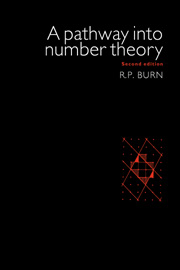Book contents
- Frontmatter
- Contents
- Preface to the second edition
- Introduction
- 1 The fundamental theorem of arithmetic
- 2 Modular addition and Euler's ɸ function
- 3 Modular multiplication
- 4 Quadratic residues
- 5 The equation xn + yn = zn, for n = 2, 3, 4
- 6 Sums of squares
- 7 Partitions
- 8 Quadratic forms
- 9 Geometry of numbers
- 10 Continued fractions
- 11 Approximation of irrationals by rationals
- Bibliography
- Index
2 - Modular addition and Euler's ɸ function
Published online by Cambridge University Press: 05 June 2012
- Frontmatter
- Contents
- Preface to the second edition
- Introduction
- 1 The fundamental theorem of arithmetic
- 2 Modular addition and Euler's ɸ function
- 3 Modular multiplication
- 4 Quadratic residues
- 5 The equation xn + yn = zn, for n = 2, 3, 4
- 6 Sums of squares
- 7 Partitions
- 8 Quadratic forms
- 9 Geometry of numbers
- 10 Continued fractions
- 11 Approximation of irrationals by rationals
- Bibliography
- Index
Summary
Congruence classes and the Chinese remainder theorem
1 If a and b are numbers in table 2.1 and you are given that 6 is a factor of a—by what can you say about the positions of a and b in the table?
2 If 6 is a factor of a — b, we write
a = b (mod 6)
and say that a is congruent to b modulo 6.
Explain why a = a (mod 6) for all integers a.
If a ss b (mod 6), prove that b ss a (mod 6).
If a ss b (mod 6) and b = c (mod 6), prove that a = c (mod 6).
3 Determine the set of all integers congruent to 0 (mod 6).
Determine the set of all integers congruent to 1 (mod 6).
Determine the set of all integers congruent to 2 (mod 6).
Determine the set of all integers congruent to 3 (mod 6).
Determine the set of all integers congruent to 4 (mod 6).
Determine the set of all integers congruent to 5 (mod 6).
These six sets are called the congruence classes or residue classes modulo 6. Use the division algorithm to prove that each integer belongs to exactly one of these classes.
4 When n is a factor of a-b, we write
a = b (mod n)
and say that a is congruent to b modulo n.
We presume here that a, b and n are integers, and n is positive.
State and prove generalised forms of q 2 and q 3 for integers modulo n.
5 By using tracing paper or by making a copy of the table, enter the numbers 0, 1, 2, 3, 4 and 5 in the appropriate square of the array given below. For example, 4 = 0 (mod 2) and 4 = 1 (mod 3).
6 By using tracing paper or by making a copy of the table, enter the numbers 0, 1, 2, …, 9, 10, 11 in the appropriate square of the array given below.
7 By using tracing paper or by making a copy of the table, enter the numbers 0, 1, 2, …, 33, 34, 35 in the appropriate square of the array given below.
- Type
- Chapter
- Information
- A Pathway Into Number Theory , pp. 22 - 47Publisher: Cambridge University PressPrint publication year: 1996

